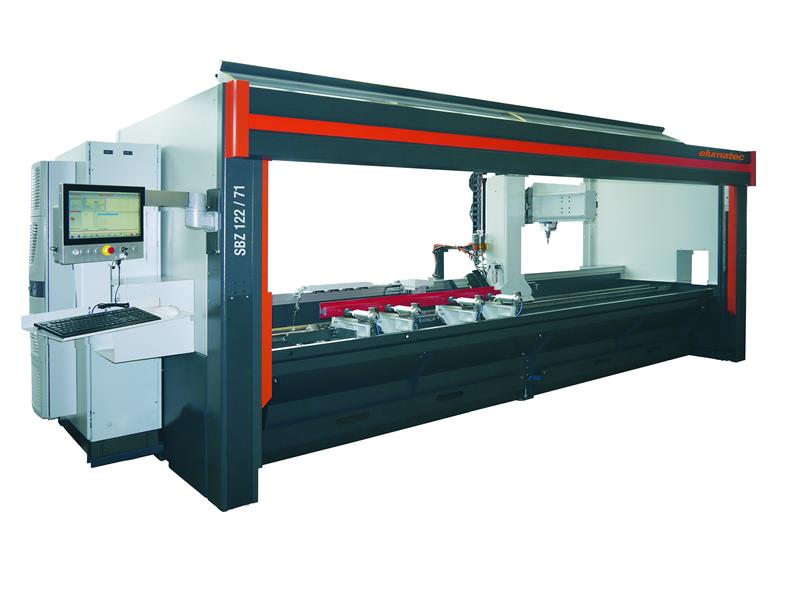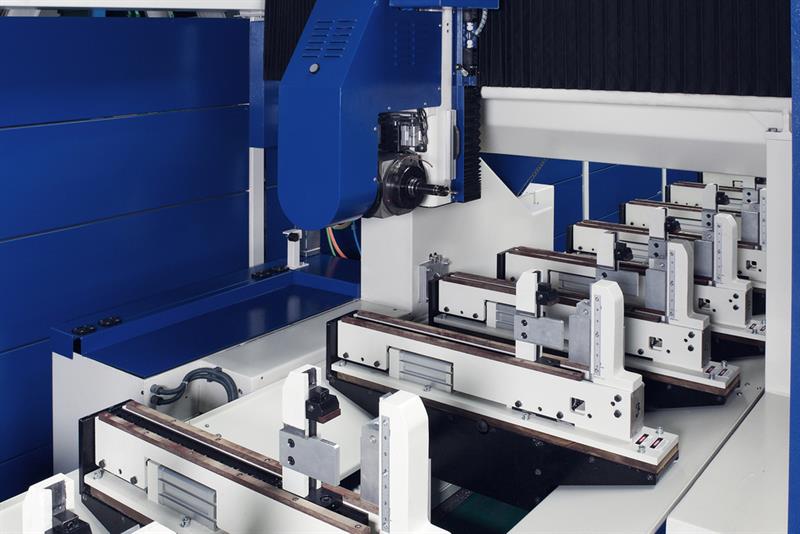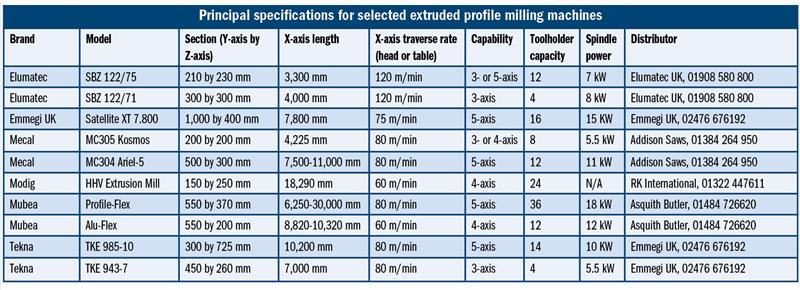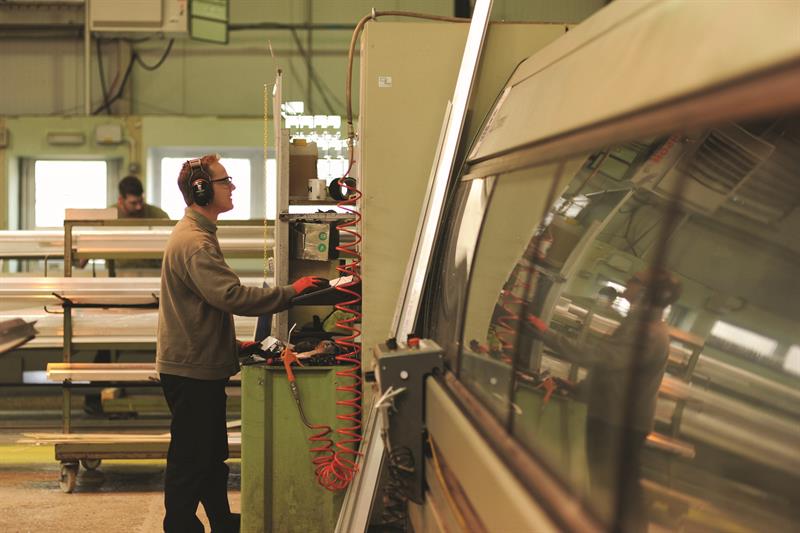Featuring a long, narrow bed with central cutting enclosure, profile milling machines resemble automated bandsaws. But they are more complex, as all offer at least three CNC axes (some more) and are more versatile, as they can mill, drill, tap and thread. Some (Elumatec SBZ 122/75; Emmegi Satellite XT; Mubea Alu-Flex; Modig HHV Extrusion Mill) can be fitted with saw attachments. Automatic toolchangers are standard and play a key role in enabling this wide range of capability for all models.
Profile milling machines can handle extrusions ranging from 4,000 mm upwards in length, but are much smaller than the double-column gantry-style CNC milling machines that would otherwise be required for parts of that scale. (An intermediate type is a wide-bed variant for processing entire panels; these include the Mubea Multi-Flex and Tekna TKE 743 and 783 models.) Finally, unlike machines for sheet metal, which can also accept very large material, these are designed to handle thick profiles; most of the extrusion milling machines reviewed here can process a section of about 500 mm wide by 300 mm high.
To do this, the extrusion is most usually clamped in a number of steady rests located over the length of the bed. In most cases, the steadies move along the bed to feed the part into the central static cutting enclosure. Inside, the cutting head may also have a limited range of X-axis motion too. Not all are configured in this way, though; some, such as the Mecal MC305 and Elumatec models SBZ 122/71 and 122/75, see the head moving over a static clamped part. Unlike many, this Elumatec extrusion milling machine is fully enclosed
Unlike many, this Elumatec extrusion milling machine is fully enclosed
With such X-axis travel, some machines (Emmegi UK; Elumatec) are able to process a shorter part at either end, doubling productivity by overlapping loading and cutting time, although for some models this capability reduces the machine’s maximum part cross-section dimension.
Other extras include a second milling head in its own enclosure to reduce processing times (Mubea Profile-Flex Twin Head) or a second parts holder (actually a second chuck in the mill-turn configuration of the Modig HHV Extruder Professional) for further part processing speed gains.
Generally, profile milling machines offer CNC motion in three axes: along the length of the part (X), and through horizontal and vertical sections of the stock (Y and Z) as standard. But some have gone beyond, offering extra axes in a variety of configurations that include fitting a nodding-head style cutting head (4-axis configuration) that might also be mounted on a turntable (5-axis set-up). The benefit here is faster production by reducing the number of clampings, just like in conventional CNC milling machines. Other designs can incorporate an optional angled head for lateral side or end-on machining (Tekna TKE 943) or from below (Elumatec SBZ 122/71).
Ralf Haspel, member of the Elumatec management board, explains why the company launched a 5-axis profiler, the SBZ 122/75, at the Bau 2017 architecture trade show in Germany last month: “Our customers need to be able to machine an extremely wide variety of profiles that keep getting more and more complex, all while making their lead times shorter and shorter.”
Another multi-axis configuration is the Mecal MC305 Kosmos; it mounts extrusions on a rocking beam (A-axis, ±67.5°). The HHV Extrusion Mill from Modig takes this design a step further by clamping the part in a 60 rpm rotating chuck. Its machining spindle is, unusually here, held horizontally. And instead of the structural or architectural sections considered standard applications, Modig is marketing this machine for aerospace applications, including seat tracks, floor beams, stringer clips/brackets, fuselage stringers, stowage bin structures and fuselage floor grid components.

Mubea Alu-Flex features a nodding-style cutting head
Asquith Butler’s Mubea machines offer an additional capability: on-board part measurement using a touch-probe. With this facility, not only can they measure part dimensions without removing them from the machine, saving time, but also the machine automatically updates the NC cutting program with the new measured values.
The control systems driving these machines are, for the most part, proprietary, although they may be able to read common CAD file formats. For example, the Elumatec ‘eluCam’ user interface is a conversational-type control that enables programming on the machine; it is complemented by eluCad programming software featuring a graphical interface. Other brands extend the role of software still further by venturing into automation; the Tekna TKE 800 and 801 machines offer semi- and fully-automated routines of profiling cycles.


BOX TEXT
A second profiler for Alitex
Aluminium greenhouse manufacturer Alitex has invested £1 million in its Petersfield, Hampshire, factory after acquiring timber conservatory maker Marston & Langinger in May 2016. Alitex now plans to manufacture Marston & Langinger garden rooms in its signature aluminium material.
To support this expansion, it has bought the second of two Emmegi Satellite XT profile milling machines. Says the company: “There are huge efficiencies to be made from the machine’s multi-handling capabilities and its ability to eliminate human error.”
Alitex estimates that the new Satellite XT will reduce machining times by up to 30%, and has calculated that a process that currently takes two hours can now be completed in just over 12 minutes. As a result of the machine’s efficiency, the company has predicted a two-year payback on the investment at Petersfield, at the same time as helping it to increase capacity in line with its new acquisition.
Jason Cottrell, head of manufacturing at Alitex, concludes: “The Satellite XT has been fundamental to our manufacturing success over the last year."
This article was published in the February 2017 issue of Machinery magazine.




